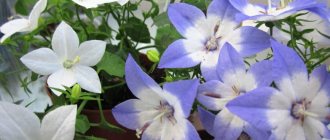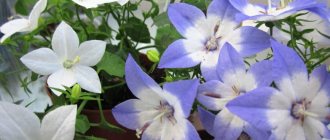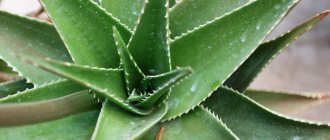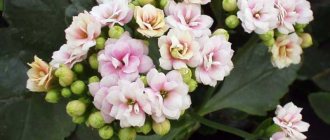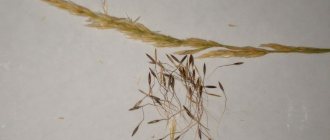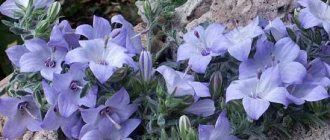What kind of plant
This delicate indoor plant, which many gardeners love so much, is popularly called the bride. This flower also has a completely scientific name. In the biological reference book it is called Campanula, which means “bell”.
White campanula in a pot on the windowsill
The houseplant campanula, or bride, is a small herbaceous perennial, about 15 centimeters in height. It has creeping, creeping stems on which there are long petioles with small (up to 5 cm) heart-shaped leaves. The surface of the leaves is light green with jagged edges.
The inflorescences are paniculate, the flowers are pale blue, lilac or white. The shape of the flowers is a five-petaled bell, the shape very much resembles a star. The size of the flowers is small - about 3 centimeters in diameter. In common parlance, the campanula with white flowers is called the bride, and its variety with blue flowers is called the groom. The period of abundant flowering lasts from the first days of June until the end of October.
Scientific name for “groom” and “bride”
In fact, the flower is a bell, so loved by everyone since childhood. And this is what the flower “bride” is called scientifically - it is a campanula, like, in fact, all known bells. The plant is perennial and herbaceous.
The “bride” or “groom” blooms at home almost without interruption. The “bride” will be especially delighted if you provide her with a little more comfort for life. And it’s worth it, because the “groom” and “bride” flowers are considered a talisman for the family.
Description
Hybrid with lilac flowers
Campanula is a well-known houseplant that belongs to the bellflower family. It can be found in the wild in many countries of Southern Europe.
A significant number of species of this plant have been cultivated and are now actively used as indoor plants.
- Campanula can be either annual or perennial.
- Plants are varied in shape, flower color, size, and there are hybrid double forms.
- Campanula equifolia is cultivated as an indoor crop. This plant is perennial, with thin shoots, sometimes creeping, in rare cases hanging down up to 25 cm long.
- The arrangement of the leaves is alternate; the leaf blades are attached to the stems with the help of elongated petioles.
- The leaf shape is heart-shaped or oval with small teeth. The leaves range in color from light green to dark green.
- The flowers are collected in inflorescences of several pieces; after flowering, a small fruit appears in the form of a box.
- Among indoor flower lovers, the most common hybrid is “Alba” (with white flowers) and “Maya” (with blue or purple flowers). People call them “the bride and groom.”
Hybrid "Alba"
All representatives of the bellflower family are not very demanding; they need the most basic things - watering, moderate lighting, and periodic feeding.
Features of the campanula
Trending Pilaf with chicken and shrimp
The genus Campanula is represented by herbaceous plants, which can be perennials, biennials and annuals. Their leaf blades are solid and alternately arranged. As a rule, the corolla has a bell-shaped shape; it can be colored purple, white, blue, and also in various shades of purple. Flowers can be single or they are part of paniculate or racemose inflorescences. The fruit is a capsule.
As a rule, only one species is cultivated indoors - Campanula equifolia, or this plant is also called “bride and groom”. This species is a perennial, the length of whose stems is about 0.3 m; they can be creeping or hanging. The greenish, alternate leaf blades have long petioles and a serrated edge; their length can vary from 30 to 70 mm. The terminal corymbose panicles consist of flowers reaching 20–40 mm in diameter. The color of the flowers can be pinkish, purple, white, blue or lilac. Most often, a couple of varieties of Campanula equifolia with a contrasting color are planted in one container, which is why this variety is called “bride and groom.”
Types and varieties popular in indoor floriculture
Not all bred varieties take root in society. Some of them remain only in nurseries, but others are becoming very common and can be found on window sills in every city.
Equal-leaved
These include popular classic varieties - Alba (white), Maya (blue) . The length of the branches reaches 30 cm, and they hang freely from the pots. The leaves are slightly carved, with long green stalks.
Important! These varieties are the most common among gardeners. It was they who were given the popular names - bride and groom.
Campanula terry
This variety has more resistant branches, and they stretch up to a certain length and do not fall off. The leaves are slightly heart-shaped and light green. Breeders obtained the variety by crossing Carpathian and portenslag campanula.
The flowers are medium-sized, double, similar to small roses. The most popular colors are blue and white, but there are pink and pale blue. This variety is one of the most finicky, and therefore has limited popularity.
Terry mini
The length of the lashes is shortened, and they are always raised up. The leaves are small and usually dark green. The flowers are miniature, up to 1.5 cm, in the shape of small roses. Like regular terry varieties, they come in white, blue and light blue. Pink ones have also been bred, but they are difficult to buy.
Pozharsky
It has several varieties, but they all have approximately the same appearance. Large leaves are located on relatively short stems (up to 20 cm) . This is one of the few varieties that can grow both in a pot and in open ground.
The flowers look more like stars, and some of them have no resemblance to bells at all. They bloom on a long peduncle, located along its length. The color is replete with a variety of shades: from white to blue with a purple tint.
Portenschlag
Ground cover variety: the stems are short, growing up to a maximum of 10 cm. Single flowers bloom at the tops in the shape of an open bell, the petals of which are slightly curled. The leaves have long petioles, a jagged edge, and are round or heart-shaped.
Portenschlag blooms like a dome over the pot. The flowers are large (up to 2.5–3 cm), white or blue.
Carpathian (carpathic)
Can be grown in pots and open ground (resistant to frost down to –40 °C). The variety was discovered in the Carpathians and became one of the popular crops in floriculture.
The length of the branched, bristly stems reaches 40 cm. The leaves are heart-shaped, light green, fleecy, with a clear pattern of veins and a jagged edge.
The flowers are bell-shaped and vary in size, depending on the subspecies. Coloration varies from white to blue and purple.
Napoli and Atlanta
Low bushes with erect stems. The leaves are medium-sized, heart-shaped, light green.
The flowers are large, about 3 cm. The color of Napoli is blue, closer to a purple hue (it is called the groom). Atlanta, respectively, is white - this is a bride's indoor flower.
Campanula Blauranka
This plant is a low-growing variety of Campanula Pozharsky. The foliage of this plant is large, and the color of the flowers is bluish. The stems can reach about 20 centimeters in length. This flower can be grown both in the garden and at home.
Diseases and pests
If you do not provide the plant with optimal conditions and violate the care recommendations, the campanula will begin to hurt and the risk of pest damage will increase. So, from excessive watering, fungal infections develop, which leads to the appearance of rot. Among the insect pests, scale insects, spider mites, whiteflies, and aphids are dangerous - periodically carefully inspect the stems and leaves of the plant for damage.
More details about everything:
Root rot
The base of the stem and petioles turn black, the leaf blades become covered with dark brown spots, which spread very quickly. The surface of the soil is covered with a layer of mold, and a putrid odor emanates from the substrate. Replant the plant immediately.
Carefully remove from the pot, cut off all affected parts (roots, leaves, stems), and sprinkle the cut areas with cinnamon, wood ash, crushed activated carbon or chalk. Soak the roots in a bright pink solution of manganese or a fungicide solution (Skor, Cuprozan, Topaz) for about 30 minutes. After these manipulations, transplant into a new container with fresh substrate, add Glyocladin to it. For 2-3 months, it is recommended to water the flower not with water, but with a solution of Previkur, Alirin, Baikal-M of low concentration (0.5%).
Gray rot
High air humidity, coolness and waterlogging of the substrate are a fertile environment for the development of the disease. Gray wet spots with a small pile appear on the plant. Cut off all affected parts and treat the cut areas as described earlier. Spray the plant with a fungicide (solution of Horus, Teldor, Switch VDG).
For a month, you should water it with a slightly pink solution of potassium permanganate and dust it with colloidal sulfur. For preventive purposes, every 3-4 months it is recommended to spray the plant with a solution of Bayleton, Topsin-M or Fundazol (concentration 0.5%, 0.3% and 0.1%, respectively).
Shchitovka
Convex growths of a dark brown color appear on the stems of the plant, and the tissue around them acquires a reddish-yellow tint. Lubricate visible shells with turpentine, kerosene or acetic acid. After 2-3 hours, remove them using cotton swabs and wash the plant under a warm shower (cover the substrate with polyethylene so that it does not get wet).
To completely get rid of the pest, 2-3 treatments will be required at intervals of 5-7 days with a solution of the fungicide Fosbecid, Fufafon or Metaphos.
Whitefly
Adults are small whitish midges that fly up at the slightest touch - sticky tape, homemade traps (cardboard + honey or other sticky substance) are very useful for catching them; a fumigator can neutralize them.
To completely destroy the pest and larvae, it is necessary to treat with Commander, Admiral, Tanrek or Mospilan at intervals of 3-5 days.
Aphid
Small black-brown or lime-colored insects accumulate in large numbers on the leaves, tops of young shoots, and buds. It is necessary to treat the plant with foam of laundry or green potassium soap. After an hour, bathe the plant under a warm shower, cut off severely damaged shoots and leaves, and sprinkle the cuts with wood ash.
Spray the campanula bush several times a day with a solution of infusion of garlic, onion peels, tobacco, and any herbs with a pungent odor. If there is no effect, treatment with a special insecticide will be required (Iskra-Bio, Inta-Vir, Biotlin or Fury, 3-5 treatments will be required with an interval of 5-7 days).
Preventive measures:
- Remember that campanula categorically does not tolerate waterlogging of the soil, do not allow this to happen;
- Keep newly acquired plants separate from others for a month;
- If symptoms of disease or pests are detected, the plant should also be quarantined;
- It is not recommended to place bouquets of flowers (especially chrysanthemums and roses) in the room;
- Ventilate the room daily, regularly spray the plant and follow other care recommendations;
- Every 10-15 days, instead of water, it is recommended to use a slightly pink solution of potassium permanganate for watering.
"Groom", "bride" and "lover"
Campanulas are equifolia primarily in color. This:
"Bride"
It is not difficult to guess that “Bride” is an indoor plant with white flowers. It looks gentle and cute.
"Groom"
“Groom” has a purple or bluish color. Blends perfectly with her snow-white friend.
"Lover" (bicolor)
A love triangle is incomplete without introducing the two-colored “lover.” The center of the flower is white, the edges are purple.
Within these groups of campanulas there is a division into varieties and species according to doubleness, shape of petals and type of shoots: ampelous (hanging) or semi-ampeloid). For example, a white “bell” can be either simple or double.
What is the name of the bride flower?
It’s interesting to know what the bride’s flower is called differently; many people know it as “bride and groom.” It received its romantic name due to its delicate buds with innocent-white, rich cornflower blue, lilac buds, similar to bells and associated with a young couple of lovers. The scientific name of the plant is campanula; it belongs to herbaceous crops and does not require complex self-care.
Indoor flower bride - how to care?
The home flower “bride and groom” is unassuming and very easy to care for. It is better to plant it in hanging pots, since campanula has long hanging shoots. How to care for a bride flower:
- Campanula likes diffused, dim light in the home; it has a positive attitude even towards light shading.
- The room must be ventilated frequently, avoiding drafts.
- The bride flower is calm about dry air, but will only be happy with spraying. Irrigation is best done around the pot, spraying air. This procedure is useful during the heating season.
- The leaves of the plant should always be kept clean to avoid damage by spider mites or aphids.
- The plant will need regular and abundant watering, but without waterlogging.
- The “bride and groom” flower is fed once every 2 weeks with a complex special fertilizer for flowering crops on a liquid base (for example, “Kemira Lux”).
- In the spring, to prepare the plant for the next flowering cycle, the tops of its shoots are cut off. Lignified campanulas stop blooming, so it is important to rejuvenate the plant. Trimming should be done when the leaves dry out, the shoots stretch out, and when greenery is rapidly developing instead of flowers.
- In winter, the plant rests, water it once a month, and place it in a cool place.
How to propagate a bride flower?
To propagate the bride flower, you can use several propagation methods:
- Young shoots. In spring, a young shoot of 10-20 cm is separated along with the “heel”. It is buried in the earthen mixture, watered with Fitosporin, and covered with a transparent container. The greenhouse is ventilated daily, and after a month the sprouts are placed in a well-lit place. Bushes that have grown 10-12 cm are pinched.
- For the Campanula plant, propagation by cuttings is important:
- At the end of summer, a well-ripened, strong 5-6 cm shoot with 3-4 pairs of leaves is cut off and placed in a weak solution of potassium permanganate for 7 hours. Then the cutting is placed in clean water, where it will take root, and planted in a peat-sand mixture.
- To create a greenhouse effect, the sprout is covered with a glass jar on top. It will need to be removed for 10 minutes in the morning and evening, then the time the seedling is in the fresh air will be extended. After complete rooting of the plant (after 3-4 weeks), the greenhouse is removed.
- After another couple of weeks, the plants can be transplanted into a substrate for adult crops. From the beginning of February they will be able to begin to bloom.
Purchasing a plant
Before you begin implementing our recommendations, you need to purchase the plant itself. You can buy it in stores by browsing the flower departments. I must say, he is not a very frequent visitor to such places. But if you are lucky, you will become the happy owner (or possessor) of this green pet.
The second purchasing option is to buy from grandmothers. Ask around, maybe someone will agree to sell you a young plant.
Checking roots
If the root system looks pretty good externally, do not rush to replant the beauty. Firstly, she needs to undergo acclimatization in your apartment or house. This is a stressful situation, and if you add to it a replanting with freeing the roots from the soil, it will not be difficult to destroy the flower.
Dilute the drug “Fitosporin” in water. The color of the concentrate should resemble strong black tea. From this concentrate, prepare a solution for irrigation: 15 drops per liter of irrigation water. Spray the plant with Fitosporin. This needs to be done as soon as you arrive home and look at the roots. “Fitosporin” will destroy fungi and spores that contribute to the spread of root and other rot.
Pest treatment
Now let's examine the green mass of the plant. Often unexpected guests “come” to us from the store - all kinds of pests that attack leaves and flowers. If light spots are noticeable or something else bothers you about the general appearance of the plant, treatment is needed. You can use “Fitoverm” or “Intavir”. Dilute the drug according to the instructions and treat the above-ground part of the plant. By the way, you can also water the ground if the soil allows it.
Trimming shrunken parts
We can say that your indoor flower “bride” has been saved. How to care next? Remove any blooms on the plant. Carefully cut off damaged leaves and broken stems with sharp scissors. Now your “bride” is almost ready for the next step of post-purchase processing.
Campanula transplant
A newly purchased campanula should not be disturbed for several days, during which time it must adapt to new conditions. After this, it must be transplanted. To do this, use a wide pot, at the bottom of which a good drainage layer is made. A suitable soil mixture must be loose, its composition: peat, humus, coarse sand and leaf soil (1: 1: 1: 1).
Next, the bush is replanted in the spring at the very beginning of active growth. But experienced flower growers advise not to replant the old bush, but to grow a new flower from cuttings in the spring.
Campanula transplant
Campanula prefers soil that is loose and rich in oxygen. This allows the plant roots to breathe well and the soil not to be compressed. The best soil mixture is a mixture of humus, rotted leaves, peat and sand, which are taken in equal volumes.
You can also prepare the following mixture: turf, leaf, peat soil and sand. They will need to be taken in proportions 6:3:1:1, respectively. A drainage is placed at the bottom, where you need to put some small pieces of coal.
The transplantation process can begin in the second half of March. However, this is done only two or three times, and then the plant will need to be renewed. This is due to its short lifespan and during this period the plant begins to lose its decorative qualities.
Another important point is which pot is best to replant the plant in. Pots or hanging pots are best suited for the “bride and groom”. The plant has a very strong and powerful root system. A shallow but wide pot will suit him.
As soon as spring comes, 3-4 rooted cuttings are planted in a pot with a diameter of about 8 cm. After two months, when roots appear on the surface, each plant is transplanted into a larger container. Small pots with a diameter of about 15 cm are suitable for this.
In general, it is recommended to plant new cuttings every year. This is one of the ways to propagate a plant.
Caring for Campanula at home
Light and warmth
Bride and groom flowers grow in indirect sunlight. But despite this, windows to the north are unlikely to suit him. Due to lack of light, the shoots will stretch out and flowering will stop. The plant will lose its beauty.
Optimal lighting conditions are created near windows facing west and east. Campanula will bloom wonderfully next to them in hanging flower pots.
If the window faces south, direct sun will burn the tender leaves. In addition, the “bride” flowers will suffer from drying out soil. If there are no other windows, the plant must be shaded to protect it from the bright sun.
The heat is harmful for the campanula, while it loves open air very much. In summer, the flower will live perfectly on the loggia or in the country house. During the warm period, the favorable temperature should be about twenty degrees. In winter, the plant needs to rest and gain strength for the next flowering. Therefore, he is provided with a temperature of no more than fourteen degrees Celsius.
Soil preparation
Universal soil for decorative flowering plants can be purchased at a flower shop. You can also cook it yourself. To do this, you will need coarse river sand, turf, dry humus, compost and leaf soil. All components are taken in equal parts. After planting, it is very important to periodically loosen the soil in the flower pot, since the plant needs oxygen, which promotes the active development and flowering of the campanula.
Additional Information. The soil for growing campanula should be light and easy to loosen. Regular black soil is too heavy for such a delicate flower.
Choosing a pot
With the arrival of spring, the plant must be transplanted into a new pot, since over the year the soil in the old pot has become very depleted and has lost its nutritional qualities. In early March, the indoor groom or bride flower must be transplanted into new soil rich in useful components.
Flower pot with bride
An overgrown plant needs a new spacious pot so that the roots do not suffer due to cramped space. After transplanting or planting, the plant goes through an adaptation period, so it should be removed away from bright sunlight and not fertilized for one week.
Watering
Campanula is distinguished by its moisture-loving nature; therefore, watering should be abundant and systematic, especially on hot days. During the dormant period, watering is carried out very rarely, approximately 1 or 2 times every 30 days, but do not allow the earthen ball in the pot to dry out. Water the flower with well-settled water, which should be at room temperature or a little warmer.
Brief description of cultivation
- Bloom . As a rule, it begins in the first weeks of summer, and Campanula fades at the beginning of autumn.
- Illumination . The plant needs a lot of bright light, but it must be diffused. It will grow best on a windowsill facing east or west. You can also place the flower on a south window, but in this case it must be shaded in the afternoon.
- Temperature regime . During intensive growth - from 20 to 22 degrees, and in the winter months - from 12 to 14 degrees.
- Watering . During the growing season, water systematically and abundantly, and during the dormant period - 1 or 2 times every 30 days. Make sure that the earthen ball does not dry out completely.
- Air humidity . Campanula grows well at the level of air humidity that is typical for living rooms. However, on hot days, as well as during the heating season, the plant is moistened from a sprayer with water at room temperature; this procedure is carried out in the evening.
- Fertilizer . In spring and summer, the flower is fed systematically once every 7 days. To do this, use liquid complex mineral fertilizer for flowering indoor plants. During the cold season, Campanula is not fed.
- Rest period . It lasts a couple of months and begins after flowering, usually from October to December.
- Transplant . It is carried out in the spring at the very beginning of intensive growth. But experts do not advise replanting an old bush; instead, it is better to grow a new flower from a cutting.
- Reproduction . By dividing the bush, by seed, by cuttings and young shoots with a heel.
- Pests . Spider mites and scale insects.
- Diseases . Gray rot.
Reproduction
If the plant has grown enough and does not fit into the volume of the container, it must be divided into several parts. Carefully remove the bush from the pot with a lump of earth. Using a sharp knife, the rhizome is cut into pieces.
Don’t forget to treat the cut areas with crushed wood charcoal. Plant the resulting parts in new containers of smaller volume. It is not recommended to immerse plants deep into the soil. Immediately after transplanting, provide the plant with plenty of water and shade.
Propagation by cuttings
Propagation by cuttings is a very simple and common method. The lower part of the shoots is taken for cuttings. All activities begin in spring. The plant wakes up and begins to grow. When young shoots reach up to 20 cm in height, they are cut off and placed in a glass or jar of water. You can immediately plant it in the ground. When planting in the ground, the cuttings are watered with a solution of phytosporin and placed in a small greenhouse. The optimal temperature for growing cuttings is 12-13 °C.
If the cuttings were planted in the summer, then in the fall they rest, and in January or February they will begin to bloom.
Reproduction methods
To propagate indoor campanula, the seed method is used, as well as cuttings, dividing the bush and planting young shoots. At the same time, vegetative methods are more popular among gardeners, since they are simpler and more effective compared to seed methods.
Cuttings
To cut cuttings, use the lower parts of the shoots remaining after pruning. For rooting, they are planted in a substrate of sand and peat, which is spilled with Fitosporin, and they are covered with a transparent dome on top. At temperatures from 20 to 25 degrees, the cuttings take root quite quickly. During rooting, the cuttings are not watered; they are only systematically moistened with a sprayer. After the cuttings reach a height of about 10 centimeters, pinch their tops to make the bushes more lush.
Reproduction by young shoots
After young shoots grow on the bush in spring, separate several pieces along with the heels. Plant the shoots for rooting in the same substrate as the cuttings, and also cover them with a transparent cap. For rooting to be successful, the shoots must be kept cool (about 12 degrees). The roots on the shoots should grow in 20–30 days; immediately after young foliage appears on the plants, remove the shelter and move them to a warm, well-lit place (the light should be diffused).
Dividing the bush
A heavily overgrown bush can be divided into parts during transplantation. Treat the cut areas with charcoal powder. After this, the divisions are planted in separate containers. The planted cuttings are well watered and protected from direct sun rays for the first days.
Growing from seeds
Seeds are sown in early spring. For sowing, use a bowl, which is filled with seedling soil mixture. Bell seeds are very small, they are evenly distributed over the surface of the substrate and covered with a thin layer of earth on top. The crops are moistened very carefully using a sprayer. The emerging seedlings also need to be watered using a spray bottle. They are picked into individual cups after they have formed 3 true leaf plates.
Diseases and harmful insects
At home, plants are much less susceptible to diseases and pests. However, they are not 100% protected. If not properly cared for, a number of problems can arise.
Gray rot
With constant waterlogging of the soil, when there is no drainage in the flower pot, the water stagnates, which in turn leads to acidification of the soil.
Gray rot thrives in damp soil. When affected by gray rot, plants wither and the root system begins to rot.
An unpleasant odor appears in the room where the flower affected by gray rot is located. Sometimes, when the rotting goes very far, the flower can no longer be saved.
In any case, first of all, you need to cut off the rotten twigs and leaves and throw away the old soil. Transplant the flower into new light soil, reduce watering.
Fusarium
If temperature conditions are not observed, as well as in the absence of light, the viability of the plant decreases.
Sometimes fusarium can be observed on the “bride and groom” flower; it is accompanied by yellowing of the tips of the leaf blades. In severe forms, the leaves die and the shoots wither from the root.
Heart rot
If you find brown heart-shaped spots with a gray coating on the leaves, then it is likely that the plant has developed brown heart-shaped rot.
This disease is caused by pathogenic microscopic fungi. To combat them, fungicides are used, while watering is reduced and the plants are regularly ventilated.
Spider mites, aphids, scale insects
If the plant is in a dry room, aphids or scale insects may appear.
At the first symptoms of these diseases, treat the plants with insecticide preparations. A proven folk remedy against aphids and scale insects is a soap solution. Spider mites are the scourge of many indoor plants. Use broad-spectrum insecticides to combat it.
An effective drug against aphids
Most often, the companula is affected by aphids
Most often, companula is affected by aphids. Aphids multiply very quickly, so control should begin when they first appear. It is better to use systemic preparations that not only destroy the pest during treatment, but also continue to act for some time in the plants themselves.
There is a drug "Biotlin" designed to protect against sucking pests.
The treatment solution is prepared at the rate of 0.5 ml of the drug per 1 liter of water. Penetrating into the plant within a few hours, the drug will protect it for at least two weeks.
Campanula growing conditions
Lighting
The outwardly fragile plant does not require special maintenance conditions or meticulous care.
Campanula is photophilous, but direct sunlight can be harmful. The most suitable place to place a charming beauty are windows facing east or west. If this is not possible, when placed on a southern window sill, shading will be required during hot midday hours, and on the northern one, artificial additional illumination with phytolamps, fluorescent lamps or fluorescent lamps will be required. Otherwise, the plant will get burned or will develop and grow poorly.
Summer holidays
It’s great if the campanula spends the warm season in the fresh air. You can take the plant outside in the spring once the threat of return frosts has subsided. They should be returned to the premises at the end of September. During this time of year, campanula blooms, so it will serve as a stunning decoration for a garden, gazebo, or balcony. Just choose a secluded corner away from precipitation and direct sunlight.
Air temperature
Moderately warm temperature has a beneficial effect on the development of campanula. So, if the plant spends the spring-summer period indoors, it is advisable to maintain the air temperature within 22-25 °C. Cool wintering has a beneficial effect on the formation of flower buds. From late autumn to spring, the temperature should fluctuate between 17-18 °C, but not lower than 15 °C.
Indoor flower Bride and Groom: folk signs and superstitions, the meaning of the flower
House bells are a symbol of a happy family life . It is popularly believed that campanula fills space only with positive energy if it is properly cared for. Moreover, she is completely unpretentious. Most often, two types of plants, white and blue, are bought for the house so that there is a pair.
Bells are able to take away negativity from the owner, hostess and other residents of the apartment in stressful situations. They say that if a flower suddenly dried up, it took away the damage, the evil eye, from one of the inhabitants of the house. In this case, the plant should be thanked and buried in the ground outside.
In addition, these flowers improve the overall mood and give a boost of energy to all residents of the apartment.
Superstitions, signs - the influence of the campanula flower on people
Flower Bride and Groom: can you keep it at home?
There are signs that some flowers cannot be kept in the house. They bring negativity into the house, as a result, those living in the house begin to quarrel, get sick, and, due to the presence of certain types of plants, even die. This flower is not one of those.
If you promise this plant good care, then it will only delight you with its beauty and positivity. So, if you decide to have such a miracle, then take it with confidence and it’s better to buy a couple of different colors at once: white, purple (blue).
What kind of energy does campanula carry?
Features of watering and fertilizing
In the warm season, the feelings of the “Bride and Groom” should not dry out, so the potting soil should be frequently and abundantly watered. In the autumn-winter season, it is enough to irrigate the soil 1-2 times a week. For this purpose, settled water that is sufficiently soft is used.
For a comfortable existence of a campanula at home, daily spraying of the flower with settled water is required. Regular humidification of the air around the “Bride and Groom” will not be amiss.
During the active growth of green shoots, the flower must be fed once every ten days with any liquid fertilizer for flowering plants.
To preserve the decorative appearance of the flower, it is important to regularly pluck dry leaves and inflorescences and trim the longest shoots.
How to grow a flower bride and groom: video
Sources
- https://pocvetam.ru/komnatnye-rasteniya/kaktusy/cvetok-nevesta-komnatnyj.html
- https://flowerf.ru/landshaftnyj-dizajn/tsvetok-nevesta-komnatnyj-kak-uhazhivat.html
- https://krrot.net/cvetok-genix-i-nevesta/
- https://rastenievod.com/kampanula-zhenih-i-nevesta.html
- https://kopilpremudrosti.ru/komnatnyj-cvetok-zhenih-i-nevesta.html
- https://41svadba.ru/vse-stati/tsvetok-zhenih-i-nevesta-nauchnoe-nazvanie-uhod-v-domashnih-usloviyah-razmnozhenie-peresadka-komnatnyj-tsvetok-zhenih-i-nevesta-primety-v- narode-kak-vyglyadet-nezabyvaemo-na-vashih-svadebnyh-fotogra.html
- https://sadovnikam.ru/474869a-komnatnyiy-tsvetok-nevesta-kak-uhajivat-posle-pokupki
- https://sadovnikam.ru/415808a-tsvetok-jenih-i-nevesta-opisanie-uhod-foto
- https://felisov.ru/komnatnye-rasteniya/cvety-zhenih-i-nevesta.html
- https://heaclub.ru/cvetok-zhenih-i-nevesta-nauchnoe-nazvanie-uhod-v-domashnih-usloviyah-razmnozhenie-peresadka-komnatnyj-cvetok-zhenih-i-nevesta-primety-v-narode
- https://TheKomod.ru/dekor/kak-posadit-tsvetok-nevesta-i-zhenih.html
